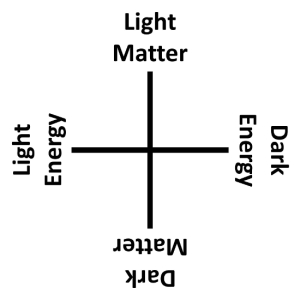What are dark matter and dark energy? We do not know; we just know of them by their effects.
Dark matter is thought to be present in halos around galaxies since the estimated amount of matter is too small to keep the galaxies rotating at their measured rate. Dark energy is thought to be present in the empty spaces between galaxies pushing them apart because the velocities separating them are actually increasing instead of slowing down. Nobody knows what dark matter and dark energy really are, but new theories are often being suggested. Perhaps one of these theories will be tested soon and we will have a better idea of what these mysterious materials and forces are.
Could it be that dark matter and dark energy are linked by an equation, like normal “light” matter and “light” energy? For ordinary matter and energy, which are really two aspects of the same thing, it is Einstein’s famous equation: E= m*c^2. But since we have no idea what the dark stuff is, we can only conjecture.
Why should we care what these things are that are so difficult to characterize? In any scientific investigation, if we have gaps and inconsistencies in our knowledge and our theories it just bothers us to no end. We’re just not happy until we figure out the puzzle. In this case, the universe is almost completely made up of these dark parts, so it seems pretty important.
Unfortunately in my diagram the horizontal axis is light energy-dark energy, which is separating, and the vertical axis is dark matter-light matter, which is combining. In many of my fourfolds the horizontal axis is combining or conjunctive and the vertical axis is separating or disjunctive. Is the energy-matter dual more important than the conjunctive-disjunctive dual? Perhaps this fourfold doesn’t really fit but I like it anyway.
Further Reading:
http://en.wikipedia.org/wiki/Dark_matter
http://en.wikipedia.org/wiki/Dark_energy
http://science.nasa.gov/astrophysics/focus-areas/what-is-dark-energy/
Eric Chaisson / Epic of Evolution
<>



